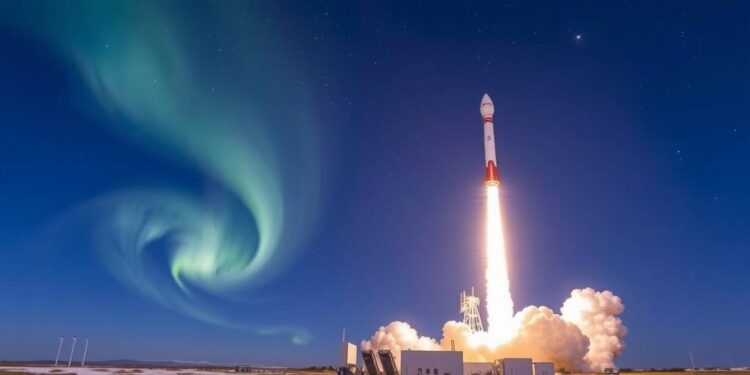NASA is poised to launch three rockets from Poker Flat Research Range in Fairbanks, Alaska, as part of an innovative experiment to investigate the intricate relationship between auroral substorms and the upper atmosphere. The timing of these launches is not just a routine scientific endeavor; it represents a critical intersection of atmospheric physics, space weather forecasting, and our growing dependence on satellite technology. By gaining insights into the composition and dynamics of the Earth’s thermosphere in the wake of auroral activity, scientists hope to obtain data that could revolutionize our predictions of space weather events, essential for the operations of GPS and other satellite-based systems.
The mission, titled Auroral Waves Excited by Substorm Onset Magnetic Events, or AWESOME, epitomizes collaborative scientific investigation, combining the expertise of researchers from the University of Alaska Fairbanks (UAF) with the technological prowess of NASA’s Wallops Flight Facility. By launching a sequence of rockets designed to measure how energy and heat are distributed in the thermosphere following substorm activity, this initiative aims to challenge prevailing theories about atmospheric behavior and composition during auroras.
During these substorms—which manifest as vibrant visual displays in the night sky—the aurora can release tremendous amounts of energy into the atmosphere. Current theories suggest that this energy primarily causes vertical motion in the upper atmosphere, which then leads to a continuous convective plume. However, Mark Conde, the lead investigator and a space physics professor at UAF, proposes a different model. He suggests that acoustic-buoyancy waves, which travel both vertically and horizontally from the auroral activity, play a more significant role in mixing air at these altitudes than previously understood. This could indicate that the impact of auroral events extends over a far broader area than researchers are currently able to measure.
The upcoming launches are meticulously planned to occur during a launch window from March 24 to April 6. This carefully orchestrated timing is aimed at maximizing the scientific yield from the experiment as it synchronizes with natural auroral occurrences. The plan includes launching two Terrier-Improved Malemute rockets and one Black Brant XII rocket within a compact three-hour timeframe. Each rocket has specific functions: the two two-stage rockets will map the atmospheric disturbances at two altitudes, while the four-stage rocket will operate at multiple points, thus gathering comprehensive data about wind movements and wave oscillations across the altitudes of interest.
Adding to the visual spectacle, colorful vapor tracers will be released from these rockets, providing not only measurable data but a stunning display that will likely be visible from much of northern Alaska. As these tracers interact with the upper atmosphere, they will provide critical insights into the changes occurring in the atmospheric composition. This data collection is further enhanced by on-ground monitoring efforts coordinated by UAF graduate student researchers stationed at various strategic locations, which will contribute to a more extensive understanding of the thermosphere’s dynamics.
One of the most compelling elements of this research is the implications for understanding atmospheric stability. The thermosphere is traditionally viewed as a convectively stable region due to its temperature structure. The warmer air rises to the top, limiting vertical movement. However, the injection of energy from auroral substorms disrupts this stability. This disruption may lead to new mixing mechanisms within the thermosphere, fundamentally altering our understanding of this atmospheric layer’s behavior in response to external energy inputs.
In a world increasingly dependent on satellite technology, the importance of understanding and predicting space weather cannot be overstated. Disruptions caused by solar flares or geomagnetic storms can have catastrophic effects on communication systems, navigation, and even power grids. By learning more about how auroras affect atmospheric dynamics, scientists aim to incorporate these insights into more robust space weather forecasting models. Improved prediction capabilities will provide critical information for the aerospace industry, telecommunications, and even daily consumer electronics.
The AWESOME mission also represents a critical advancement in how atmospheric science views the interplay between solar phenomenon and terrestrial effects. Confirming the role of acoustic-buoyancy waves in thermospheric mixing could alter the trajectory of future research, prompting scientists to reevaluate existing models and methods of analysis. It embodies the spirit of inquiry, as researchers challenge established norms to uncover a deeper understanding of our atmospheric system and its connection to the cosmos.
The significance of these findings extends beyond academic interest. They may prompt engineers and technologists to consider the atmospheric variables when designing satellite systems or instrumentation intended for space. As such, the outcomes of this research could have far-reaching effects on how we approach satellite technology and resilience against the naturally fluctuating dynamics of Earth’s upper atmosphere.
In conclusion, the upcoming NASA-funded rockets’ launches not only promise a wealth of scientific data but also have the potential to transform our understanding of atmospheric dynamics in relation to auroral activity. The experimentation’s dual focus on empirical observation and theoretical questioning positions it at the forefront of current atmospheric research. As we venture into a future reliant on satellite technology, the lessons learned from this mission may equip us with the tools necessary to navigate and mitigate the atmospheric challenges that lie ahead.
Subject of Research: Interaction between auroral substorms and the Earth’s upper atmosphere
Article Title: NASA’s AWESOME mission to Reveal Secrets of the Thermosphere
News Publication Date: March 2024
Web References: NASA
References: Not applicable
Image Credits: NASA/Rachel Lense; NASA/Lee Wingfield
Keywords
auroras, thermosphere, space weather, NASA, atmospheric research, acoustic-buoyancy waves, geomagnetic activity, rocket launches, atmospheric dynamics




